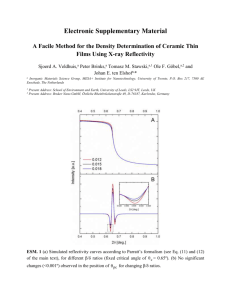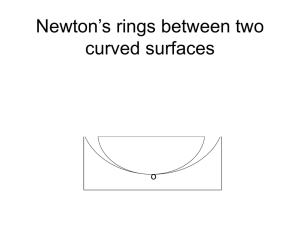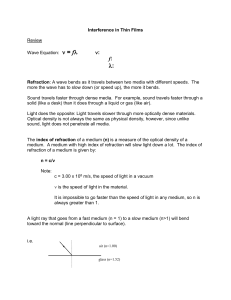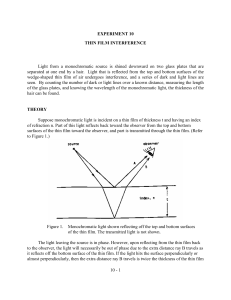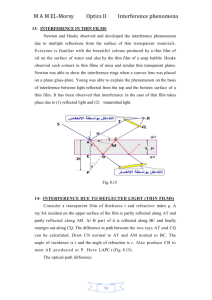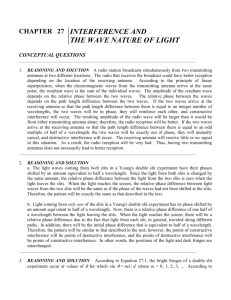Thin Film Interference: Physics Presentation
advertisement
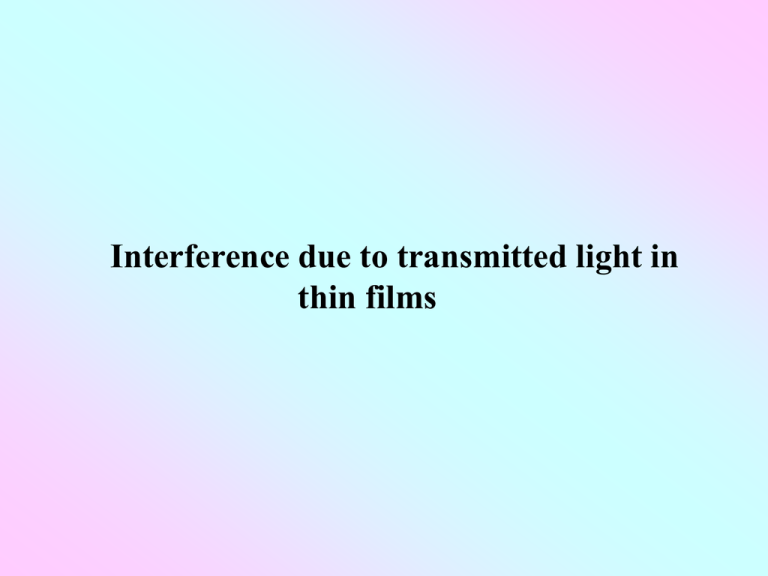
Interference due to transmitted light in thin films P P Ss rr ii A AIR AIR C C C’ A tt r r B B r r r r i r r i i M M DD AIR AIR i NN Q R Q Here at B reflection takes place at the rarer Medium .so no phase change change occurs. BM normal to CD and DN normal to BR. So optical path difference between DQ and BR is x = (BC+CD) -BN n1sini = n2sinr Sinr = sini =sini/sinr In BND, In BMD, sini=BN/BD sinr=MD/BD =sini/sinr =BN/MD BN = MD Since <CPB=<CBP=r and BC=CP=CD x = (BC+CD) –BN = (DP)- (MD) = (DP-MD) = (MP) In BPM cosr = MP/BP So MP = BP cosr = 2t cos r since BP=2t SO, x = PM = 2 t cos r Conditions for constructive interference will be 2 t cos r = n And conditions for destructive interference will (2n 1) 2 t cos r 2 One of the important applications of the thin film interference is reducing the reflectivity of lens surface. ar n1 n > n 1 2 ai at n2 n1 n 2 ar a i a ir n1 n 2 2 n1 at ai ait n1 n 2 ai, ar, at are amplitudes of incident,reflected and transmitted waves. n2>n1 , ar is negative showing that reflection occurs at a denser medium a phase change comes n1 n 2 2n1 r ,t n1 n 2 n1 n 2 r and t are reflection and transmission coefficients a r’a t’a n2 n1 n 2 n1 2n 2 r' r, t ' n 2 n1 n1 n 2 4n1n 2 1 tt' 1 2 ( n1 n 2 ) 2 n1 n 2 2 r n1 n 2 These are the Stokes’ relations. Non reflecting films • Reflectivity is the fraction of incident light reflected by a surface for normal incidence. • Reflectivity depends upon the refractive index of the material. It is given by 1 1 2 • For glass = 1.5. • Reflectivity = 0.04 • 4% of incident light is reflected for normal incidence. Remaining 96% is transmitted. • The loss of energy due to reflection is one major reason of clarity reduction. There is also a reduction in the intensity of the images since less light is transmitted through the lenses. • When films are coated on lens of prism surface the reflectivity of these surfaces is appreciably reduced. • Initially the coating were made by depositing several monomolecular layers of an organic substance on glass plates. • Now it is done by either evaporating calcium or magnesium fluoride on the surface in vacuum or by chemical treatment of the surface with acids which leave a thin layer of silica on the surface. • No light is destroyed by non reflecting film, but there is redistribution means decrease in reflection results increase in transmission. Thickness of nonreflecting thin film 1 a r 2 air(a) t film(f) glass(g) g f> a Two interfering beams will interfere constuctively if 2ftcosr = n Rays will interfere destructively if 2ftcosr = (2n+1)/2 For normal incidence <r=900 2ft = (2n+1)/2 So 2ft = /2 for min thickness, n = 0 t 4 f If a film having thickness of /4f and having refractive index less than that of the glass is coated on glass, then waves reflected from the upper surface of the film destructively interfere with the waves reflected from the lower surface of the film. Such a film known as a non reflecting film. ar r, t 1 a 2 ar’tt’ na nf r’, t’ at ar’t ng Amplitude of ray 1 = ar Amplitude of ray 2 = ar’tt’ na nf 2n a r ,t na nf na nf nf ng 2n f r' , t ' nf ng na nf na nf 2n a ar a, at a na nf na nf nf ng 2n a 2n f ar' tt' a nf ng na nf na nf nf ng 2n a n f a 2 (n a n f ) n f n g For complete destructive interference ray 1 and 2 must Have the same amplitude, i.e. nf ng na nf 4n f n a a a 2 na nf na nf nf ng 4n f n a is verynearlyqeual to unity 2 n a n f nf ng na nf a a na nf nf ng nanf nang n nf ng 2 f nanf nang n nf ng 2 f n na ng 2 f nf na ng This equation gives the estimate of refractive index of This film which should be coated on a surface to reduce Its reflectivity. If na= 1 (for air) and ng = refractive index of glass then n f refractiveindex of thinfilm ng nf ng

